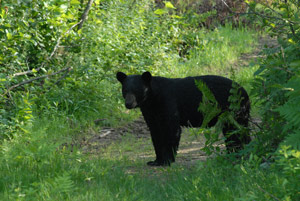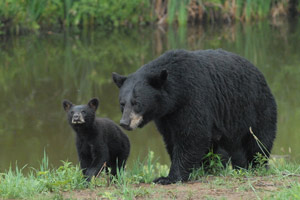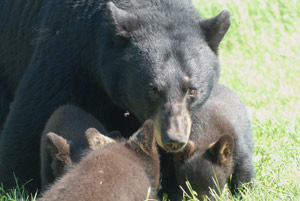Killing of nursing mothers in the spring
The biggest issue is the killing of nursing female black bears [in the spring]” There is no way to prevent this from happening in the spring bear season, either through hunter education or timing of season. Nursing female bears often forage at great distances from their cubs. When pursued by hounds, the female bear usually leaves the cubs in a tree and continues to elude the hounds. When she trees, she is seldom with her cubs. Many nursing females do not bring cubs to bait sites initially but will as they grow older and as she becomes less wary at the site. There remains great contention between hunters and bear biologists/managers as to the ability of hunters to accurately assess nursing status of bears. The conclusion of most biologists is that it is quite difficult to accurately determine nursing status on free-ranging black bears, even when a bear is in a tree or at bait. The appearance of nursing females in the kill each spring supports this notion. During the last year of spring bear hunting in Colorado, the number of nursing female black bears checked was within three of the number predicted based on breeding rates of females and total female kill. In other words, there was no selection even with regulations prohibiting the taking of nursing females. Proponents of spring hunting usually point out that most states protect females with cubs by regulation. The regulation looks good on paper but is very difficult to implement in the field because of bear behavior.
Tom Beck Bear Biologist
How Do Bears React to People?
 Black bears may enter camps or your cottage or home, especially when wild foods are scarce, but they rarely attack people.
Black bears may enter camps or your cottage or home, especially when wild foods are scarce, but they rarely attack people.
Black bears usually retreat before people are aware of them. Their hearing is more sensitive than a human’s, and their broad, soft foot pads allow them to move quietly downwind where they can best identify their dangers. They may stand upright to see farther (not a sign of aggressiveness). If need be, they can run faster than 25 mph or climb trees quickly.
They generally prefer to forage for wild foods away from people but are almost as quick as chipmunks to seek food in campsites and garbage cans when wild nut and berry crops fail. They rarely attack people. Campground bears and roadside panhandlers may nip or cuff people that crowd around them, try to pet them, or tease them with food. But the injuries, if any, are usually slight, only occasionally requiring stitches.
Full-blown attacks by black bears are rare. Black bears attacks are usually not at campgrounds and are usually not by black bears that are familiar with people. How likely is a black bear to be a killer? The 500,000 black bears in North America kill fewer than one person per 3 years, on the average, despite hundreds of thousands of encounters. To put this in perspective, for each death from a black bear across North America, there are approximately 17 deaths from spiders, 25 deaths from snakes, 67 deaths from dogs, 150 deaths from tornadoes, 180 deaths from bees and wasps, 374 deaths from lightning, and 90,000 homicides in the United States alone (data from the National Center for Health Statistics, 1980-1983). In the rare event of one of these attacks, the best defense is to fight with fists, feet, rocks, or anything hard.

Playing dead is usually not the best action with black bears.
Unlike grizzly bear mothers, black bear mothers seldom attack people in defense of cubs. Black bear mothers typically bluff or retreat. Researchers who routinely capture cubs by chasing them up trees have not been attacked even when they have held the screaming cubs. The ferocity of mother black bears is one of the biggest misconceptions about this species.
Credit: University of Minnesota – Dr. Lynn Rogers
People & Bears Can Co-Exist
People need correct information about bear behaviour and their biological requirements. This allows an appreciation for these animals and encourages the will to coexist. People and bears can coexist.
Bears are very strong and quick. Bears can be dangerous, however, the possibility of a bear harming people is overstated. Bears have the power to inflict great damage but for some reason they exhibit tremendous restraint when dealing with people. Bears that allow themselves to be seen by people don’t tend to be a threat to human safety. This is documented. In addition, so called nuisance bears have not attacked and killed anybody that there is record of. Some times a bears nervous behavior is misinterpreted for actions of aggression and the bear is unfairly dispatched.
 Education about bear behavior can reduce the need to live trap and relocate but the need does arise. Relocation of a bear should be a last resort to solving a people/bear conflict. A good reason for relocating a bear is when human activity is too hard to manage. Examples are parks, schools and areas where the number of people reduce the opportunity to encourage the bear to move on by removing the attractant (ie-peoples food, bird seed, food for pets).
Education about bear behavior can reduce the need to live trap and relocate but the need does arise. Relocation of a bear should be a last resort to solving a people/bear conflict. A good reason for relocating a bear is when human activity is too hard to manage. Examples are parks, schools and areas where the number of people reduce the opportunity to encourage the bear to move on by removing the attractant (ie-peoples food, bird seed, food for pets).
Conflict Resolution – Human and Bear ie: Nuisance bears
Successively relocating a bear with a full stomach greatly reduces the chance of that bear homing immediately. Relocate to an area featuring good bear habitat and release a bear that is comfortable because it is not thirsty or hungry will reduce the chance of return because the animal is content enough to explore the new area instead of thinking only of a bellyache and quickly returning to an area where the bear knows it can find something to eat. Some bears will return. My experience has been about one in ten relocated bears return to the area of conflict as identified by an ear tag.
Only move females with cubs when all options are exhausted.
The bears well being and long term survival are carefully considered as well as people’s fear and concerns.
Credit: Mike McIntosh
Harmless Bluster
Bear Center researchers see bluster when bears are nervous and crowded but reluctant to leave because of cubs, food, or being cornered.
The researchers usually give these bears space, out of respect, but find them easy to chase away. These researchers have never had a blustery bear come after them and make contact. Bluster is how bears talk about situations without fighting or retreating. If bluster fails, bears have retreated in every situation these researchers have seen.
(see video below)
Common bluster involves nervous bears that pounce toward a person or another bear, slap the ground or an object, and blow. Sometimes blowing takes on a guttural quality that sounds almost like a growl.
Less commonly, a bear rushes (bluff-charges) toward a person rather than just pouncing. In the video, a mother bear rushes toward the camera. When she gets close, she blows and clacks her jaws as she turns to retreat. Clacking the jaws is a sign of fear.
Bear Center researchers, like most people, used to think clacking (also called jaw-popping or chomping) was a threat. Then they saw a distant bear almost fall out of a tree, grab on quick, and clack its jaws. No one was around for the bear to threaten. Clacking simply meant the bear was afraid, which helped explain why "bears that clack do not attack."
Another sound bears use in tense situations is huffing. Bears huff when tension eases, just as a person might take a deep breath after being frightened. Retreating bears often huff when they feel safe enough to stop running. Treed bears often huff when they decide it is safe to descend.
Click here to download this video
The harmless nature of all these ritualized displays is evidenced by the facts that they do not lead to attacks and that 5-pound cubs make these displays toward people they would never dream of attacking.
The video shows cubs making blustery pounces followed by adults making the same displays.
The cubs look cute and the adults look scary, but their displays are equally harmless. A bear can be blustery one second and calm the next.
Some researchers believe bluster relieves tension. Bluster does not mean a bear is getting ready to attack. As with all bear communication, bluster simply expresses the emotion of the moment.
Many people kill blustery bears because they mistakenly think bluster means the bear is aggressive and likely to attack.
How dangerous are black bears?
In working closely with wild bears for the past 40 years, I have gradually become more and more comfortable with them as I learned their "language" and how they think. I have learned to trust certain bears and bear families to the extent that they mostly ignore me as I walk and sleep with them for up to 24 hours at a time.
I used to think black bears were very dangerous, but my thinking evolved in much the same way people have changed their attitudes about gorillas. I now interpret aggressive displays by black bears in terms of their fear rather than mine.
Their most common aggressive displays are merely rituals they perform when they are nervous. When I see any bluster, I feel safe. It means the bear wants to talk about the problem it has with me. I have never had one come after me and hurt me. The only times I have been bitten is when I initiated the contact.
Black bears have killed 61 people across North America since 1900. This no longer worries me. My chances of being killed by a domestic dog, bees, or lightning are vastly greater. My chances of being murdered are 60,000 times greater. One of the safest places a person can be is in the woods.
In working closely with wild bears, I have used bad bear manners on occasion and been slapped, but the slaps were not that damaging - usually just welts. This was a hard slap by a mature female whose claws were fully spread to nine and a quarter inches wide.
The damage from a slap is nothing close to the folklore that a bear can disembowel man or beast with a swipe of the paw. Black bear claws are strong for climbing trees, but not sharp for holding prey. Grizzly bear claws are even duller because they are used for digging.
A big revelation to me was how reluctant black bear mothers are to defend their cubs against people, even when the family is cornered in a den and I'm trying to stick the mother with a needle to tranquilize her. Defense of cubs is more a grizzly bear trait. There is no record of anyone being killed by a mother black bear defending her cubs, and attacks are very rare. We routinely capture black bear cubs in the presence of mothers and have never been attacked.
Black bears are so timid today partly because they evolved alongside such powerful predators as saber-toothed cats, American lions, dire wolves and short-faced bears, all of which became extinct only about 12,000 years ago. Black bears were the only one of these that could climb trees, so black bears survived by staying near trees and developing the attitude: run first and ask questions later. The timid ones passed on their genes to create the black bear of today.
That timid attitude still serves black bears well now that people have spread across North America. Startled black bears run away, often to a tree. By contrast, a startled grizzlies may charge and occasionally attack, making grizzlies over 20 times more dangerous than black bears.
What should people do if they see a black bear in the wild? Basically, enjoy it. We like to make ourselves inconspicuous to watch them longer before they discover us and run. To make the bear run away, step out and wave and say "Hi, I'm a human!" We have seen a lot of advice to avoid eye contact and avoid running away, but we have been unable to find any instance where doing these things has precipitated an attack. Fearful people usually tell us "I ran one way and the bear ran the other." We don't recommend climbing trees.
Offensive attacks are very rare and include all of the killings by black bears. These are generally unprovoked predatory attacks in remote areas where bears have the least contact with people. Bears that visit campgrounds, bird feeders, and garbage cans almost never kill people, even though these bears have by far the most contact with people. The 750,000 black bears of North America kill less than one person per year on the average, while 1 out of each 16,000 people commits murder each year across North America.
Most attacks by black bears attacks are defensive reactions to a person who is very close, which is an easy situation to avoid. Injuries from these defensive reactions are usually minor.
Carrying a small can of pepper spray is a good way to feel self confident around black bears. It works as well on bears as it does on dogs. They don't go away mad, they just go away. This 4-year-old girl made this bear run away by spraying it in the eyes. The next day, the girl saw the same bear and it ran up a tree.
Bears can look like they are stalking when they are actually approaching out of simple curiosity. Will a bear attack because it senses you are afraid? No. Most people who find themselves near a black bear ARE afraid, and they are not attacked. Black bears are not territorial toward people like some dogs are. Black bears are mostly afraid THEY will be attacked. If a person doesn't want a black bear to come closer, act aggressively.
Black bears that come into campgrounds are looking for food, not people, and can easily be chased away in most cases. In our experience, no matter how bold and confident bears seemed, they still recognized aggressive behavior and ran away when someone yelled and ran toward them. Besides pepper spray, throwing stones is also effective, especially if you yell and act aggressive at the same time.
As people learn more about black bears, fewer and fewer people feel they must shoot them on sight, and people enjoy seeing them. We don't recommend touching wild bears because they may react defensively with a nip or a slap. However, the many people who interact closely with wild black bears across North America incur few injuries, showing that black bears are not as dangerous as most people have thought.
Can we co-exist with black bears? The residents of Hemlock Farms, Pennsylvania suggest we can. Seven thousand residents share their seven square mile town with over 20 black bears. That's 3 bears per square mile, a higher density than is found in any national park. In that town, seeing a bear is not a problem - they enjoy seeing the bears.
